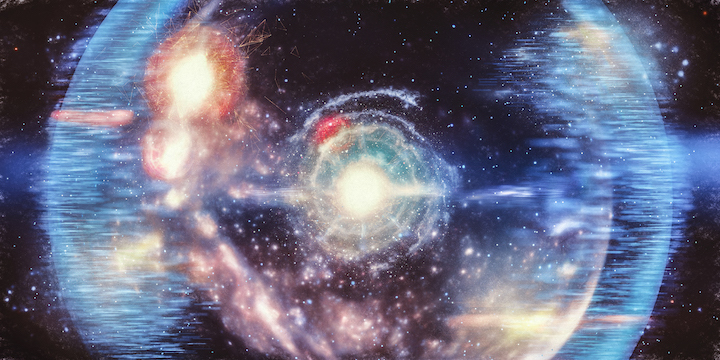29.01.2021

One of the lingering mysteries of the universe is why anything exists at all.
That's because, in the universe today, matter and its antimatter counterpart should form in equal amounts, and then these two oppositely charged types of matter would annihilate each other on contact. So all the matter in the universe should have disappeared as soon as it formed, canceling itself out on contact with its antimatter counterpart.
But that didn't happen. Now, new research hypothesizes that early in the universe, there was a mysterious "kick" that produced more matter than antimatter, leading to today's imbalance. And that imbalance may have also led to the creation of dark matter, the mysterious substance that tugs on everything else yet doesn't interact with light.
Coincidence or conspiracy?
We don't know what dark matter is, but it's definitely out there. It makes up about 80% of all the matter in the universe, far outweighing the stars, galaxies, dust and gas that we can see.
And while dark matter is certainly a heavyweight in our universe, it is, oddly, not that much of a dominating factor.Typically, in physics, when one process dominates an interaction, it really takes over. Unless other physics comes into play, rarely do two competing forces come out in balance. For example, when the forces of gravity and electromagnetism compete inside a giant star, eventually gravity always wins and the star collapses. So the fact that dark matter is 80% of the mass in the universe — and not 99.99999% — and regular matter is 20% as opposed to zero, strikes physicists as odd. An 80/20 split doesn't seem even when it comes to, say, sharing lotto winnings, but to an astronomer, the two amounts are practically the same.
Compounding the issue is that, as far as we know, the generation of regular matter and dark matter had absolutely nothing to do with each other. We have no clue how dark matter originated in the early universe, but whatever it was, it's currently outside the bounds of known physics.
And regular matter? That's a whole other kettle of particles. In the extremely early universe (when it was a second old), physicists suspect that regular matter was in perfect balance with antimatter (which is the same as normal matter but with an opposite electric charge). We suspect this even split because we see this kind of symmetry play out today in our particle colliders, which can replicate the extreme conditions of the early universe: If you have a high-energy reaction that generates regular matter, it has an equal chance of generating antimatter instead.
But at some point (we're not exactly sure when, but it most likely happened when the universe was less than a minute old), the balance between matter and antimatter shifted, and regular matter flooded the universe, relegating antimatter to obscurity.
So, on one hand, we have a massive symmetry-breaking event that led to regular matter winning over antimatter. On the other hand, we have a completely mysterious event that led to dark matter becoming the dominant — but not super dominant — form of matter in the universe.Perhaps these two processes are connected, and the birth of dark matter was related to the victory of matter over antimatter, the new study proposes.
Mining for goldstone
In the study, published online Dec. 29, 2020, in the preprint database arXiv and not yet peer-reviewed, researchers make this claim by relying on something called the baryon number symmetry. Baryons are all of the particles made of quarks (such as protons and neutrons). The symmetry simply states that the number of baryons entering an interaction must equal the number exiting it. (They're allowed to change identities, but the total number must be the same.) The same symmetry holds for reactions involving antiquarks.
This symmetry reigns in all of our experiments in the present-day universe, but it must have been violated in the early cosmos — that's how we ended up with more matter than antimatter.
And in physics, every time a symmetry of nature gets broken, a new kind of particle, known as a "Goldstone boson," pops up to enforce the breaking of the symmetry. (In the modern universe, for instance, the pion is a kind of Goldstone boson that appears when a symmetry of the strong nuclear force is broken.)
Maybe the dark matter is a kind of Goldstone boson, associated with the breaking of baryon number symmetry in the early cosmos, the study proposes.
Kicking the can
The researchers behind the idea call it "the kick." Baryon number symmetry is never broken in our experiments, but something exciting must have happened in the early universe. It was a violent but brief event, snuffing out almost all antimatter. And whatever exotic mix of conditions happened, the baryon number symmetry broke, allowing a new Goldstone boson to appear.
So, the thinking goes, during that singular event, the universe became flooded with dark matter particles. But then, whatever conditions that led to the symmetry breaking ended, and the universe returned to normalcy. By then, however, it was too late; the dark matter — and all the rest of the matter — remained.
So after that first epic minute of the universe's history, once symmetry returned to the universe, dark matter was relegated to the shadows, never to interact with normal matter again.
And the reason that there is (very roughly) the same amount of dark matter and regular matter is that they were related, the study claims. The new model doesn't predict the exact 80/20 split between dark and normal matter. But it does suggest the reason that dark matter and normal matter are in roughly equal balance is because they had their origins in the same event.
It's a very clean and intriguing idea, but it still doesn't explain exactly how that early symmetry breaking took place. But that's for another paper.
Quelle: SC
